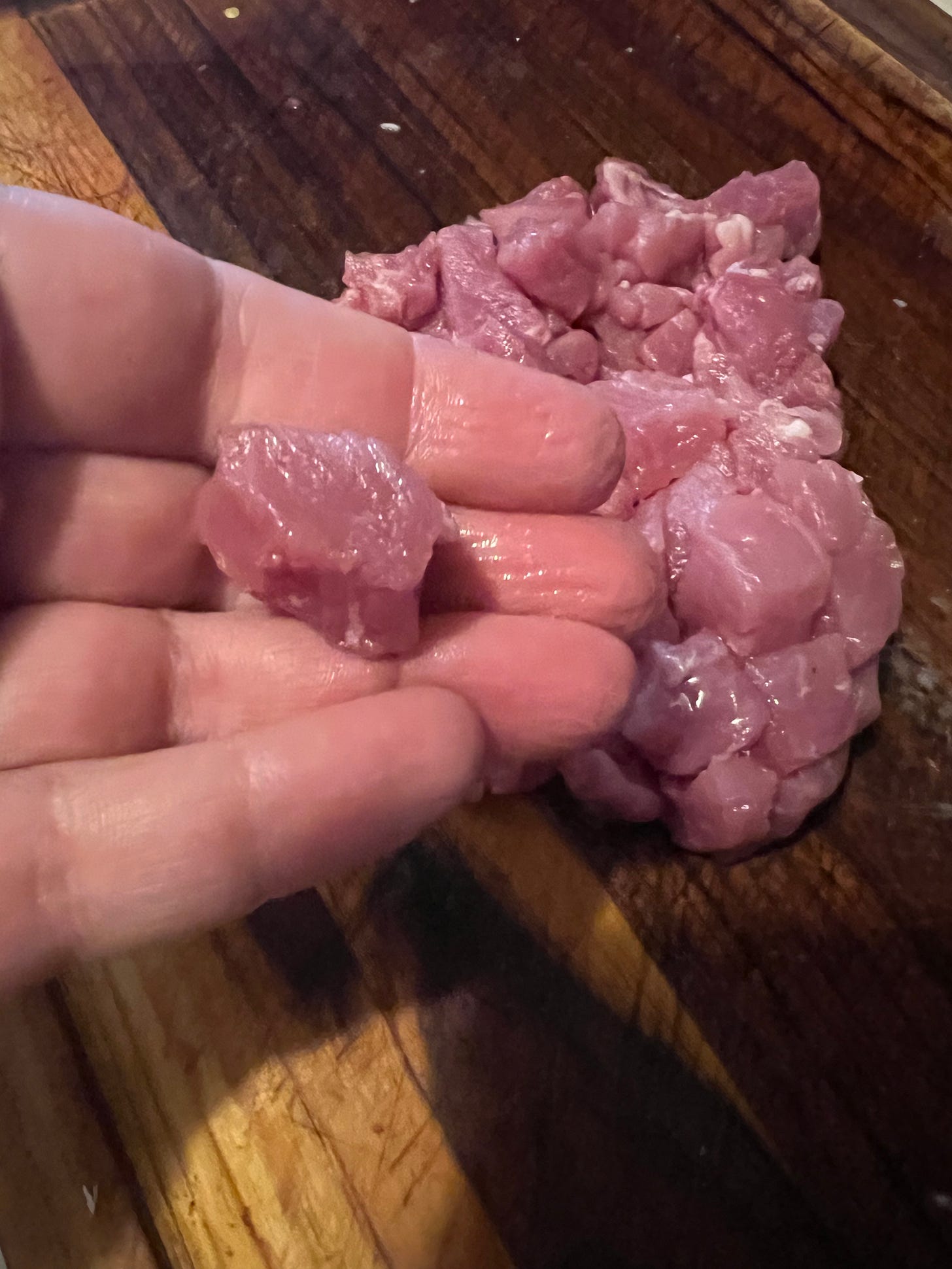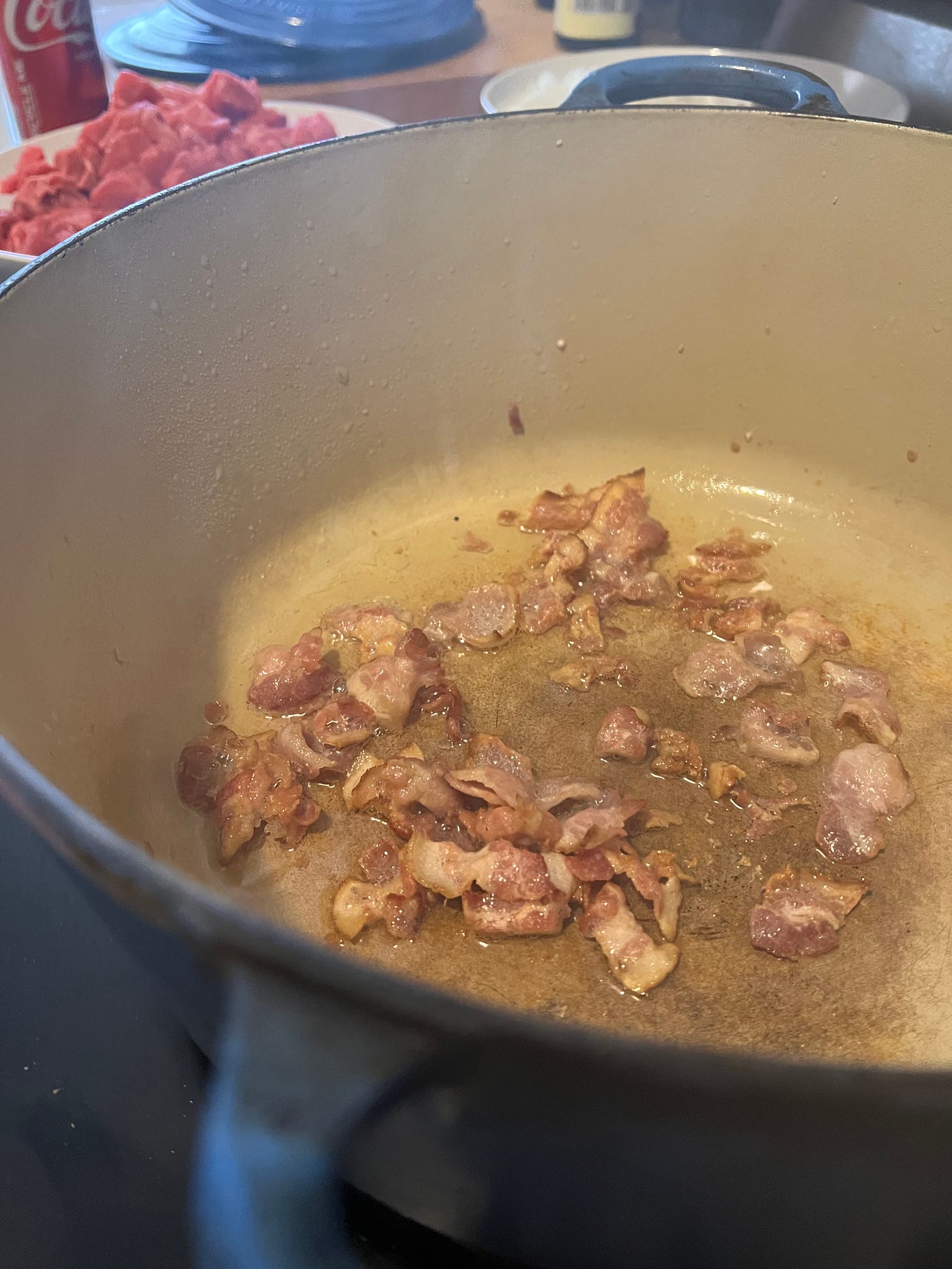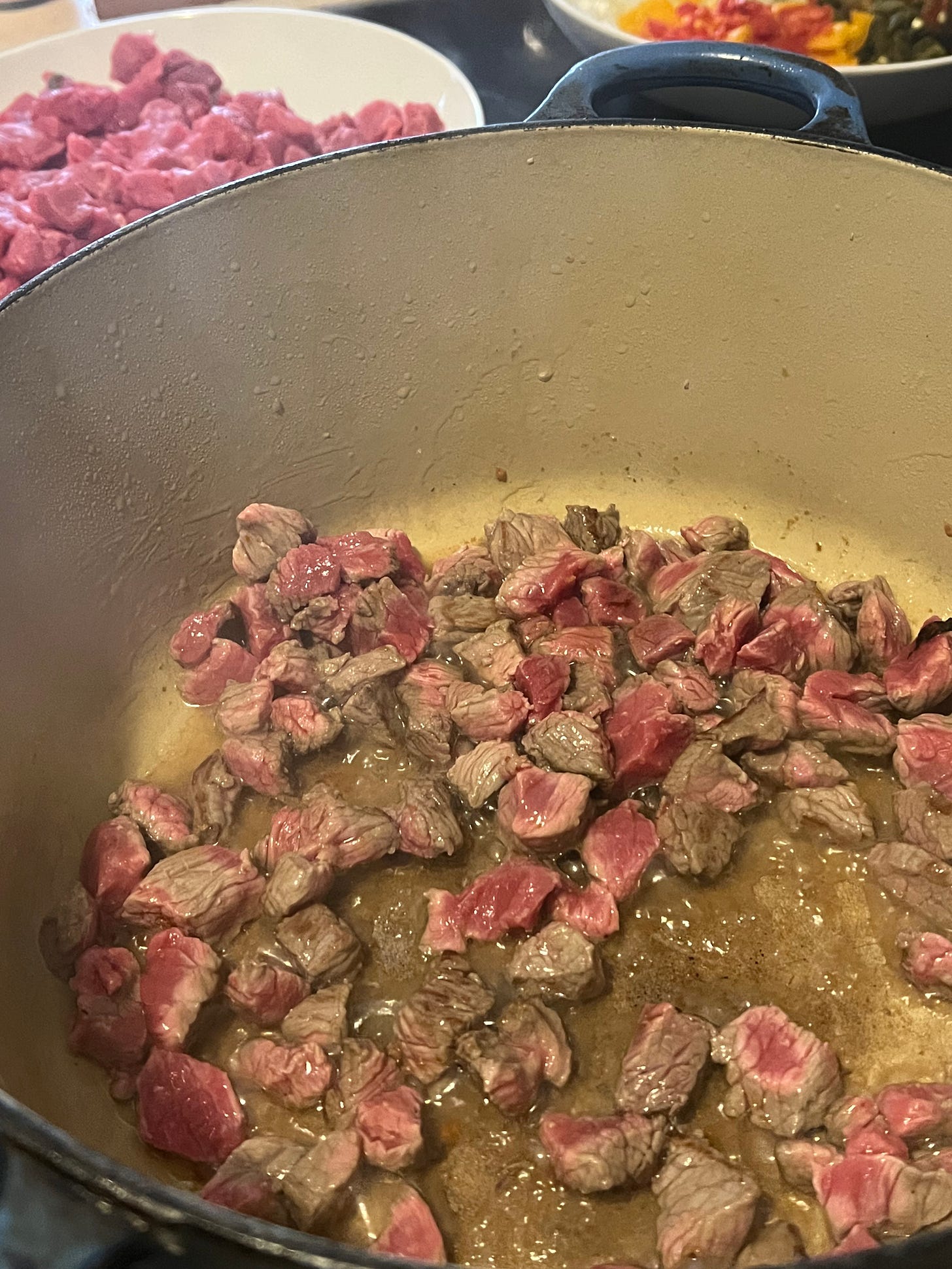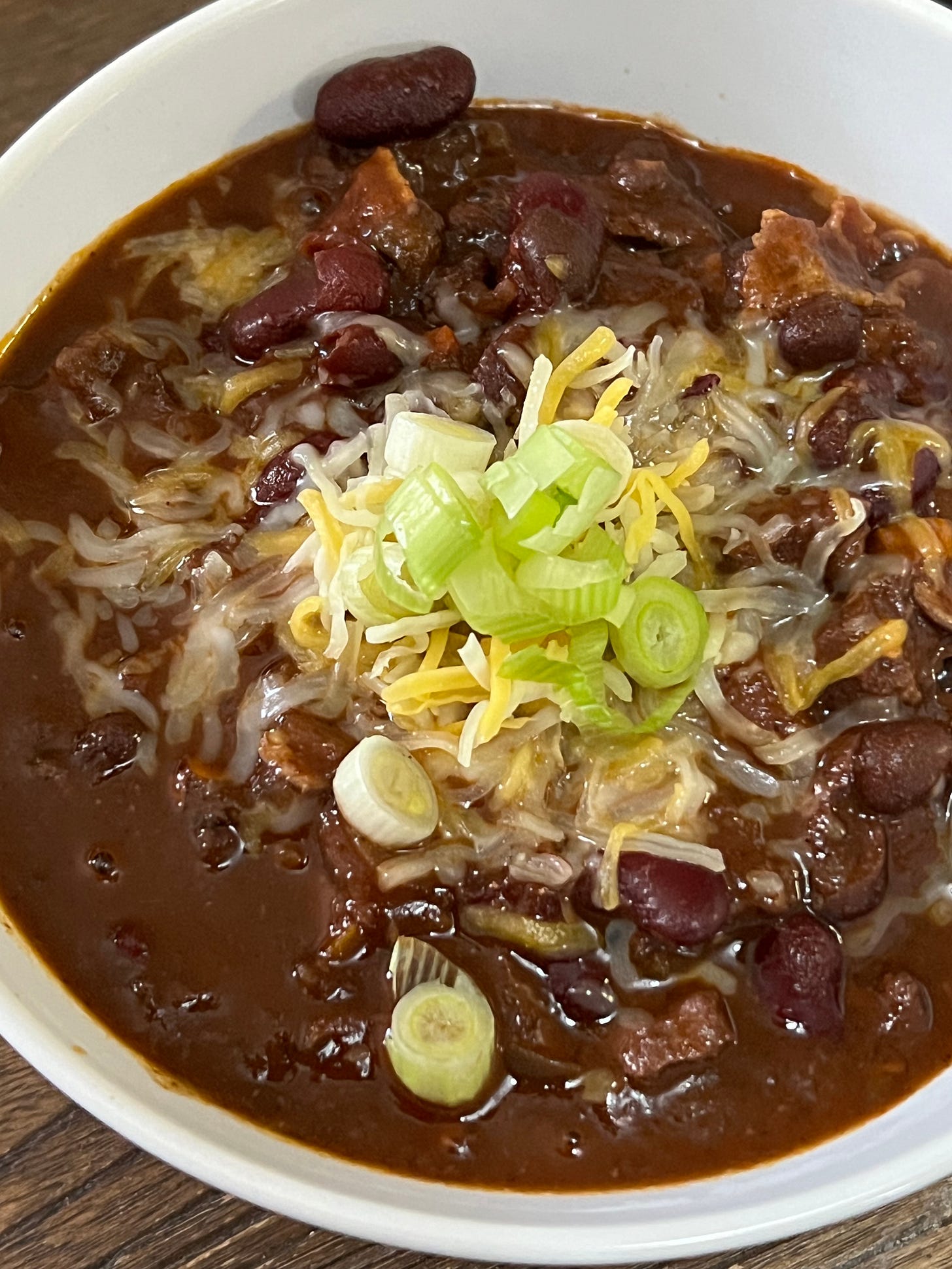Well, the iguanas are falling back home in Florida so that means only one thing: it’s chili season.
Chili is one of those things like gumbo where there’s an infinite number of ways to make it and almost all of them are great. Unfortunately, the great debate over chili remains: beans or no beans? For that of course, we can thank Texas, which is usually at the heart of bad food opinions.1 In this case, it’s the Lonestar position that beans do not belong in chili, and we can only assume that it is because of this stance that the state has been cursed with Greg Abbott.
So I am here, dear reader, to set the record straight, or at least give you my take on chili. I thought this might be fun and besides, are those other history blogs going out of their way to make sure you’re fed? I didn’t think so.
Warning: I really have no idea how to cook for a single person, so prepare yourself to feed an army. Or at least a bunch of friends.
Ingredients:
2 lbs stew meat (you’re gonna cook this low and slow for a while so don’t worry about expensive cuts of meat)
1 lb pork loin
6 strips of bacon
2 onions
2-3 bell peppers
additional peppers for heat/flavor (I like the jarred chipotles in sauce, but adjust for your preference)
3 cans of beans (I use roughly a can per pound of meat. I also prefer two cans of kidney beans in sauce with a can of black beans, but make sure to drain and rinse the black beans first)
small can of tomato sauce
tomato paste
1 1/2 bottles of red wine (I usually keep leftover wine in my kitchen for cooking. This is a great way to make sure that you don’t have too much to drink for fear of wasting it. Not that I’m worried about alcohol—I just can’t handle the calories. My metabolism is slower than the DMV)
Spices. I like a mixture of kosher salt, cracked black pepper, chili powder, garlic powder, cayenne, and a hint of coffee. I used to be snobby about store bought varieties but I’ve found that Kinder’s makes a really good spice mix but you’ll need to add salt to taste as you finish.
DO NOT ADD: tomatoes. I’m talking to you, MOM. This is the reason I left home.
With all that, here’s how you do it.
First, do all your prep work first. I work in reverse order on my chopping, starting with my onions and peppers. One of the things that I’m looking for is a consistency in size of onions and peppers as well as the beef and pork. In this case, what I’m trying to do is give my take on the Cajun trinity, only instead of celery, I substitute an additional pepper. Basically what you want is a 2-1-1 ratio of onions to bell peppers to peppers. I used roasted Pueblo chiles as my third pepper, and put all of them in bowl as you see here.
I then cut up the beef and the pork into roughly half inch cubes. I’m imagining how a spoonful of chili will feel on the palate and I want room for everything. Consistency is key here. It’ll also help the meat break down and absorb flavors over time. Here’s the size beef and pork cuts I like.
Next I chop a few strips of bacon. You don’t have to worry about separating them. Just give a rough chop. Mostly you use this for the grease anyway.
Now that prep work is complete, you can begin.
I use my large blue Le Creuset Dutch Oven that I named George (like in the Marvin the Martian episodes where the alien will hug him and kiss him and love him and name him George.)
Step one: cook our bacon over medium high heat. Don’t go crazy on the heat during any of this process, but especially now. You don’t want to burn the grease. Remove the bacon from the rendered fat and set aside. You’ll add this later.2
Step two: brown your beef and pork in batches. You don’t have to worry about cooking the beef all the way through—it’ll finish in the sauce. I think for this, it took me three batches for the beef and one for the pork. Remove and set aside.
Step three: add your trinity of vegetables and seasonings. You may need to add a bit of wine to deglaze the pan. That’s fine. After you cook down the vegetables a bit, add about three tablespoons of tomato paste and the can of tomato sauce. Mix all together.
Step four: add the meat back in, along with your beans
Step five: add your wine. I used a bottle and a half for this. Remember that you are going to cook this low and slow for hours. It will reduce. Also remember that you’re not making chili for tonight. You’re really making it for the nights to come.
Step six: turn your heat to low/medium low, put the lid on and let it do its thing. Ideally you’ll let this cook for about four hours or so, stirring every so often to ensure that nothing sticks. Doing it this way will allow the meat to totally break down and all the flavors to come together.
Step seven: After a few hours, take a look at your chili. Give it a taste. You’ll likely need to adjust seasoning here, but it’s easier to add salt/pepper than to take away. Remember that. This is also your chance to reduce any liquid and cook it down a bit. But remember that it will reduce in the fridge overnight so don’t go crazy.
Step eight: it’s time to eat! Garnish however you like. I know some people like sour cream (I don’t) but it’s up to you. I usually add shredded cheese and some green onions.
And that’s about it. Chili isn’t hard. It just takes time. Oh, when I cook I like to play music. Here’s a playlist I like when I cook.
Hope you’re having a great weekend.
Jason
Sorry y’all, but when it comes to barbecue, pork is king.
“Bacon in chili? Are you a madman?”











I’m born and raised in Texas and prefer beans with my chili. My mom (from Texas) and dad (from Oklahoma) made it with pinto beans because it tastes better that way. As for BBQ, the best ribs and sausage are pork, but beef brisket is the best BBQ, and because pigs and cows are such incredible creatures, I have difficulty eating any of it.